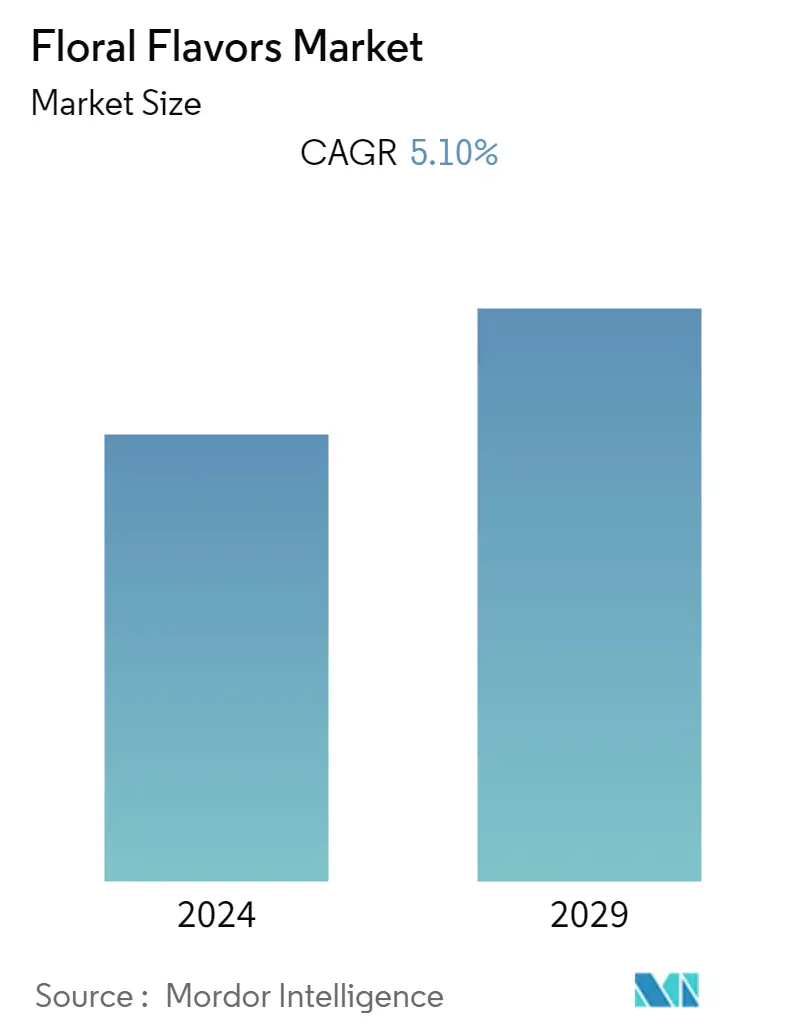Market Size of Floral Flavors Industry

| Study Period | 2019 - 2029 |
| Base Year For Estimation | 2023 |
| Forecast Data Period | 2024 - 2029 |
| CAGR | 5.10 % |
| Fastest Growing Market | Asia Pacific |
| Largest Market | North America |
Major Players.webp)
*Disclaimer: Major Players sorted in no particular order |
Floral Flavors Market Analysis
The floral flavors market is projected to register a CAGR of 5.1% over the next five years.
- Floral flavors have found favor among food and beverage manufacturers seeking more natural and botanical ingredients. Some of the most commonly used floral flavors include jasmine, rose, hibiscus, elderflower, lavender, orange blossom, and chrysanthemum, providing exotic tastes that offer a touch of adult sophistication to food and beverage products. Additionally, floral flavors are also increasingly being used with fruit flavors as they tend to complement the sweet and tangy fruit flavors.
- Thus, floral flavors are increasingly being used in food and beverage product launches including yogurt, beer, tea, and other products. Health-conscious consumers across the world are opting for clean-label and natural-based food and beverages, due to which production of natural and organic products is increasing in the market. Owing to this, the demand for floral flavors is increasing in the market.
- In recent years, artificial flavorings, such as benzophenone, ethyl acrylate, pyridine, and styrene, are identified as carcinogens, and thus, are being replaced by natural flavorings across the global market. On the other hand, flavors such as Hibiscus have numerous health benefits and have been used as a medicinal remedy for centuries.
- Additionally, the trend of consumption of flavored tea and coffee is also increasing across the world and the market is also increasingly making use of floral extracts in tea and coffee beverages. The addition of floral flavors in frozen desserts is also a trend as it provides a unique taste to the products. In February 2022, Baskin Robin's launched a rose-flavored ice cream called Secret Admirer in the market. Over the medium term, the demand for floral flavors is expected to increase owing to the increasing demand for processed food and beverages and natural food products.
Floral Flavors Industry Segmentation
Floral flavors are ingredients extracted from flowers that can be used in different applications. The floral flavors market is segmented by application into beverage and food products. Food products have been sub-segmented into dairy, bakery, confectionery, and other foods. the market is segmented by geography into North America, Europe, Asia-Pacific, South America, and the Middle East and Africa. The market sizing has been done in value terms in USD for all the abovementioned segments.
| Application | ||||||
| Beverages | ||||||
|
| Geography | |||||||||
| |||||||||
| |||||||||
| |||||||||
| |||||||||
|
Floral Flavors Market Size Summary
The floral flavors market is experiencing a notable expansion, driven by a growing consumer preference for natural and botanical ingredients in food and beverages. This trend is particularly evident as manufacturers increasingly incorporate floral flavors such as jasmine, rose, hibiscus, elderflower, lavender, orange blossom, and chrysanthemum into their products, offering exotic tastes that appeal to health-conscious consumers seeking clean-label and organic options. The shift away from artificial flavorings, due to health concerns, has further bolstered the demand for natural floral flavors, which are also being integrated into a variety of products, including yogurt, beer, tea, and frozen desserts. The rising popularity of flavored tea and coffee beverages, along with innovative product launches like Baskin Robin's rose-flavored ice cream, underscores the market's growth potential.
Regionally, North America leads the floral flavors market, with the United States playing a pivotal role due to its dynamic food and beverage sector. The demand for floral flavors is fueled by consumer curiosity for new products and the introduction of floral-flavored beverages by food service and quick service restaurants. The market's competitive landscape is characterized by significant activity from key players such as BASF SE, Firmenich SA, and Sensient Technologies Corporation, who are focusing on product innovation, strategic partnerships, and acquisitions to enhance their market presence. Recent business combinations and acquisitions, such as DSM and Firmenich's agreement and Sensient's acquisition of Flavor Solutions, highlight the industry's commitment to expanding flavor portfolios and leveraging technological advancements to meet the increasing demand for organic-based products.
Floral Flavors Market Size - Table of Contents
-
1. MARKET DYNAMICS
-
1.1 Market Drivers
-
1.2 Market Restraints
-
1.3 Porters Five Forces Analysis
-
1.3.1 Threat of New Entrants
-
1.3.2 Bargaining Power of Consumers
-
1.3.3 Bargaining Power of Suppliers
-
1.3.4 Threat of Substitute Products
-
1.3.5 Intensity of Competitive Rivalry
-
-
-
2. MARKET SEGMENTATION
-
2.1 Application
-
2.1.1 Beverages
-
2.1.2 Food
-
2.1.2.1 Dairy Products
-
2.1.2.2 Bakery Products
-
2.1.2.3 Confectionery Products
-
2.1.2.4 Other Food Applications
-
-
-
2.2 Geography
-
2.2.1 North America
-
2.2.1.1 United States
-
2.2.1.2 Canada
-
2.2.1.3 Mexico
-
2.2.1.4 Rest of North America
-
-
2.2.2 Europe
-
2.2.2.1 Germany
-
2.2.2.2 United Kingdom
-
2.2.2.3 France
-
2.2.2.4 Spain
-
2.2.2.5 Italy
-
2.2.2.6 Russia
-
2.2.2.7 Rest of Europe
-
-
2.2.3 Asia Pacific
-
2.2.3.1 India
-
2.2.3.2 China
-
2.2.3.3 Japan
-
2.2.3.4 Australia
-
2.2.3.5 Rest of Asia Pacific
-
-
2.2.4 South America
-
2.2.4.1 Brazil
-
2.2.4.2 Argentina
-
2.2.4.3 Rest of South America
-
-
2.2.5 Middle East and Africa
-
2.2.5.1 South Africa
-
2.2.5.2 Saudi Arabia
-
2.2.5.3 Rest of Middle East and Africa
-
-
-
Floral Flavors Market Size FAQs
What is the current Floral Flavors Market size?
The Floral Flavors Market is projected to register a CAGR of 5.10% during the forecast period (2024-2029)
Who are the key players in Floral Flavors Market?
BASF SE, Firmenich SA , Carbery Group (Synergy Flavours), Sensient Technologies Corporation and International Flavors and Fragrances Inc are the major companies operating in the Floral Flavors Market.

